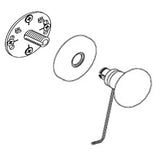| IMAGE | DESCRIPTION |
 |
28-Degree Latch A latch that requires less rotation on the handle to disengage the latch mechanism. Useful for people with ergonomic concerns, like users who suffer from arthritis. |
 |
Backset The backset is the distance from the edge of the door to the center of the 2-1/8" bore hole. In the U.S. there are two common backsets for residential locks, 2-3/8" and 2-3/4". We will pack your locks with a 2-3/8" or 2-3/4" latch depending on which backset you specify. |
 |
Bore A round hole made using a drill, commonly used in reference to tubular door lock preparations. |
 |
Brass An alloy of copper and zinc, brass is the mark of a high-quality product in a market where the use of cheaper alloys is becoming more and more common. |
 |
Bronze Bronze is a metal alloy consisting primarily of copper that is commonly used in decorative metal work. It was particularly significant in antiquity, giving its name to the Bronze Age. |
 |
Deadbolt Latch A non-spring-loaded locking mechanism that can only be disengaged by rotating the lock cylinder via key or thumb turn. |
 |
Door Pull A fixed pull attached either directly to a door or with a backplate. |
 |
Door Prep The dimensions that a door must be bored or mortised in order for a handle set to be installed. |
 |
Double Cylinder A deadbolt featuring a keyway on the exterior as well as a keyway on the interior. |
 |
Dummy Function Dummy sets have no latch and are surface mounted so you can install a dummy set wherever you choose on the door, but they are usually located to match the appearance of nearby operating locks. |
 |
Drive In Latch A drive-in latch fits into a 1” round hole on the edge of the door and contains no face plate. It does not require any special preparation or mortising. |
 |
Electronic Locksets A lockset using a keypad input and a user code to engage or disengage the latch bolt. |
 |
Full-length Entry Set An entry set with a plate that spans the entire length, from the deadbolt to the bottom of the handle grip. |
 |
Handing Levers and some handle grips are either right-handed or left-handed depending on the orientation in which the door opens and the side the hinges are located. |
 |
Interconnect Device The interconnect device provides an emergency egress function on tubular handle sets. When the deadbolt is in the locked position, simply turning the knob or lever will open both latches. It is especially handy in a fire or many other panic situations. |
 |
Key-In-Lockset A knob or lever that includes a keyed cylinder that locks from the face of the hardware set instead of requiring a separate deadbolt and bore hole in the door. Often used in place of an entry set for secure entrance to the home or for a back door entrance. |
 |
Lost Wax Cast An ancient practice in which a bronze sculpture (in our case door hardware) is cast from a wax model. The wax model is dipped in a slurry of silica, then more ceramic material is added creating thick walls around the model. At this point the wax is melted out of the ceramic, and you are left with an empty ceramic mold. Molten bronze is then poured into the ceramic mold creating a bronze reproduction of the original wax model. |
 |
Monolithic Entry Set An entry set with a plate that spans from the top of the deadbolt to the top of the handle grip. |
 |
Mortise Lock A lockset that fits in a mortised door, featuring a rectangular hole that a mortise lock body slides into. |
 |
Multi-Point Lock Door locks that offer multiple latching points with one locking mechanism. |
 |
Passage A handle set without an internal locking mechanism. A passage set is used on a door that doesn't require privacy. For example, between a living room and a kitchen or closet. |
 |
Passage/Privacy Latch A spring-loaded mechanism that slides its bolt into a strike plate on a door jamb, securing the door shut and disengages when the attached knob or lever is turned. |
 |
Patina An aesthetically pleasing sheen or coloration that signifies a bronze object's age. Patinas are produced by chemical action, oxidization or sulphuration, during the course of time. |
 |
Privacy A handle set with a locking mechanism. |
 |
Privacy Pin A pin that engages the privacy feature on the latch from the interior side of the rosette. Can be disengaged in an emergency by inserting a narrow object (like the end of a paperclip) into the emergency release hole on the exterior rosette. |
 |
Projection The furthest distance and object extend off of a surface, like a door or cabinet. |
 |
Re-Keying The changing of a lock’s internal pins in order to make the tumbler combination fit a different key. |
 |
Rosette A decorative trim plate that goes between the knob/lever/handle and door, used in both door and cabinet hardware. |
 |
Sectional Entry Set An entry set with separate plates for the deadbolt and handle grip. |
 |
Single Cylinder A deadbolt featuring a keyway on the exterior and thumb turn on the interior. |
 |
Spring Hinge A hinge that has a built-in spring that can facilitate the self-closing of a door when it is not propped open. |
 |
Stainless Steel A highly corrosion-resistant grade of steel containing Chromium. |
 |
Strike Plate The metal plate installed on the door jamb that receives the latch bolt when the door is closed. |
 |
Thumb Press The flat stub located above the handle on an entry set that disengages the latch bolt. |
 |
Thumb Turn The turn piece located on the inside trim of a deadbolt that engages/disengages the latch mechanism. |
 |
Tubular Lock A lockset requiring bored (round) holes rather than a chiseled rectangular mortise door preparation. |
 |
Wrought Steel Steel that is worked to resemble the rustic hand craftsmanship of wrought iron, which is not commonly produced any more. |
Holiday Save Up to 10% with Promo Code: SAVEMORE
